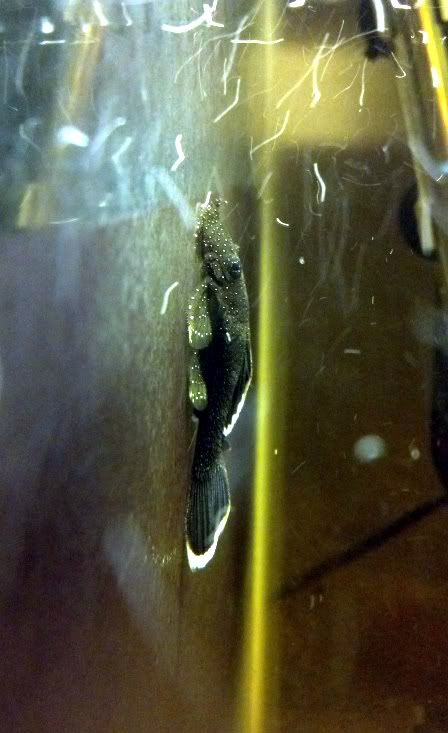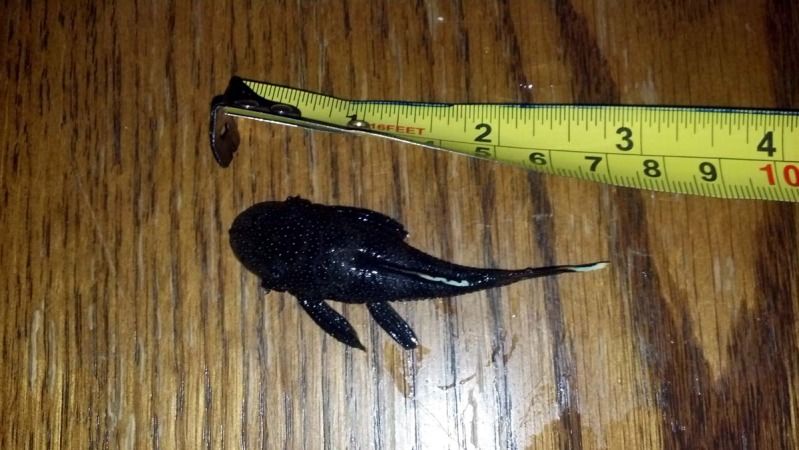Page 1 of 1
Sex my L183
Posted: 25 Apr 2012, 05:47
by ZeeZ
Is it a male or a female? Let me know if this picture's not good enough. If it's not, then I'm going to have to dig him/her out because it's always hiding except at night.

I'd also like to try to start a breeding project with it. I've read that these guys really LOVE low pH, so I'd have to get a RO unit in order to lower my pH enough for it to breed. Has anyone ever gotten any plecos that normally breed in low pH water to breed in normal pH for me, (7.6)? Is it even possible?
Re: Sex my L183
Posted: 25 Apr 2012, 06:35
by Barbie
How big is this fish? It looks 2" ish? If that is correct, it is definitely male. You can also touch the nose of said fish. If it's squishy, it's male.
The fertility rate for this specific fish at anything over a pH of 7 is very low, IME. A TDS under 100 and a pH of 6.5 will be necessary for good hatch rates.
Barbie
Re: Sex my L183
Posted: 25 Apr 2012, 08:17
by ZeeZ
No, he's fully grown in this photo, 4 inches. I've had him since September 10, 2011 when he was one inch long. I don't think he's sexually mature yet, as I've read it takes L183s two years to reach maturity, but then again, bsmith, the guy I got him from, said it surprised him how quickly his L183s bred.
So this guy isn't fertile because he's been kept in a pH of 7.6, or that's only when trying to breed them? What is TDS?
Sounds like I'm definitely going to have to get a RO unit and use RO water if I want to start this breeding project. Plus I don't have other L183s yet to do the project and they're not cheap as adults. Even if I got juveniles now, I'd have to wait potentially years before they reached sexual maturity. Looks like this project will have to be put on hold...
Re: Sex my L183
Posted: 25 Apr 2012, 10:45
by MatsP
If fully grown, I'd probably say female. It would be great to have a photo from above.
TDS = Total Disolved Solids, measured as mg/l or ppm (parts per million), but what most people actually mean is "electrical conductivity but with a different scale", because it is TDS measured with an electric meter which measures the electrical conductivity of the water, and converts that to a ppm value [1]. Both are essentially measures of "how much minerals (salts) are there in the water" - typical soft water is low TDS, hard water has higher TDS. [However, hardness is a SPECIFIC set of mineral compounds, magnesium and calcium, that is found in some water - it's perfectly possible to have "technically soft" water with high TDS - for example, if there is a lot of table salt in the water, the TDS will be high, but sodium is not a "hardness" mineral.]
RO water should come out of the RO unit at around 10-15 ppm TDS.
[1] "True" TDS is measured by taking a (quite large) quantity of water, and evaporating it off, typically at 180'C - this is why you see "Analysis at 180'C" on bottles of spring water, or similar - and then weighing the residue left.
--
Mats
Re: Sex my L183
Posted: 25 Apr 2012, 14:34
by jac
It's a female.
I have a large breeding group. Males develop the tentacles at a quite early age.
Re: Sex my L183
Posted: 25 Apr 2012, 21:27
by Linus_Cello
We got some from the same seller too. I did a group buy with someone else in our fish club. My fish are with his fish until they pair up; he got some from another vendor to diversify the gene pool. Hopefully they'll breed soon and there'll be fry available in the club.
Any other advice on breeding these guys welcome.
As for soft water, what about collecting rain water instead of doing RO? Or what about softening water with peat moss (put peat in plastic 40 g garbage can and letting the water sit in there a week).
Re: Sex my L183
Posted: 26 Apr 2012, 03:30
by ZeeZ
I'll try to get a better photo of her in a bit.
I read that peat moss isn't effective because the water will slowly go back to the pH it was before even after being soaked in peat moss. It's not as effective as RO.
Rain water, though, now there's an idea...
Looks like I joined the right forum if I want to do the breeding project since there are others here with L183s. All of the forums I'm on, very few have them. Hopefully I can pick some up from you guys or you guys can point me in the right direction.
Re: Sex my L183
Posted: 26 Apr 2012, 07:49
by Barbie
The pattern and trim on the fins really look to be from a much smaller than 4" SL fish. Could you put a plastic ruler in with it when you take a picture please? 
Barbie
Re: Sex my L183
Posted: 26 Apr 2012, 10:16
by ZeeZ
Took her out of the tank. Turns out I was wrong, she's not fully developed. She's 3 inches, not 4. I also touched the nose and it wasn't soft, it was hard.

I couldn't get a good angle so I took her out for 5 seconds to get a quick snapshot -

When I put her back in the tank, she went down and sat on a smaller piece of driftwood for about 5-8 seconds before swimming off and going back under the largest driftwood and stuck to it upside-down as she typically does.
Re: Sex my L183
Posted: 26 Apr 2012, 11:36
by MatsP
Looks like a female from the body shape - she's got "curvy hips".
Peat moss will soften water, but it all depends on where you start from. It's a bit like putting salt on a snowy driveway. If there's three feet of snow, you'll need an awful lot of salt, where if there is three inches, you'd get away with half a shovelful or so. Similarly, if you start out with water that is 300+ ppm TDS (and mainly calciumbicarbonat - so typically hard water), then you'd need a big bag of peat to make a small amount of soft water... So whilst it can be done, it's not very practical. If you have medium hard water or soft, you may be able to get away with using peat.
I had a look at this:
http://www.qualitywatertreatment.com/ci ... _guide.htm
and looked up Greensboro - but it's looking like you are close to the "harder water" parts of NC [if I'm looking at the right place - it's not an area of the US that I've spent much time in - I've been to Charleston, SC and up in New York, but that's a long way from Greensboro...]
Rainwater should be soft, and as per discussions elsewhere, unless you live in a heavily polluted area, should be OK to use in your aquarium. Only slight problem is variable levels of supply - so you either need large storage or an alternative when it doesn't rain for a few weeks. [And of course, a suitable way of collecting the rainwater - I live in a flat, and I don't have any way that I could store collect rainwater without interfering with my downstairs neighbour...]
--
Mats
Re: Sex my L183
Posted: 26 Apr 2012, 19:15
by Karsten S.
Hi,
A L 183 with 4" is definitely not fully grown, my male had 7", the female 6" and this is not particularly big for this species.
The offspring had already 4" after one year and I had males that had not more tentacles than the big female, only with 5" (~4 months later) they developped signifivcantly more tentacles and therefore reached maturity.
However, I agree that it's looks more like a female that is way too small for its age.
Cheers,
Re: Sex my L183
Posted: 27 Apr 2012, 07:02
by ZeeZ
I live in a rental house and I'm pretty sure I could put a tote under one area of the roof where it's always pouring off in streams when it rains and store water in that. I may have to find a 55 gallon drum or something similar because a tote wouldn't be very sturdy full of water over a long period of time, especially when being moved. I'd also have to figure out a way to keep debris out so it stays clean.
Kamas, I think you're talking about a L182, which is the same thing as my L183 except the L182 grows bigger. I think my L183 isn't even one year old yet. I got her Sept 10, 2011 when she was one inch, and I don't know how long it takes for a L183 to reach one inch. Judging from what I've read, my L183 isn't ready for breeding yet, anyway, since she's not even fully grown at 4" yet.
Re: Sex my L183
Posted: 27 Apr 2012, 20:15
by Karsten S.
Hi,
ZeeZ wrote:I think you're talking about a L182, which is the same thing as my L183 except the L182 grows bigger.
no, I'm not. It's easy to tell those apart and you certainly don't need the size for this.
Wild caught A. dolichopterus can reach up to 10 or even 12".
Cheers,
Re: Sex my L183
Posted: 27 Apr 2012, 20:45
by ZeeZ
Then why have almost all of the care sheets I've seen for L183s state they reach only 4"?
Re: Sex my L183
Posted: 27 Apr 2012, 21:57
by Karsten S.
Hi,
well, I don't know. Here at PCF in the data base it says 10cm SL that means around 13 cm total length which is still much too small.
Here:
http://www.l-welse.com/reviewpost/showp ... roduct/197 you can find more accurate information.
According Ingo Seidel you also can find specimen (wild caught) up to 30 cm, but this is certainly not common.
When you have tank bred specimen the males usually grow up to 16 or 18 cm, the females remain a bit smaller.
Cheers,
Re: Sex my L183
Posted: 12 May 2012, 15:53
by ZeeZ
Thanks for all of the information! Apparently my female is not fully grown. Soon I'll be looking for more Starlights, hopefully someone would be willing to sell adults...
I have a question about breeding L183s, will a pH of 6.4 be fine for them to breed in? The KH/GH of my water is low.



